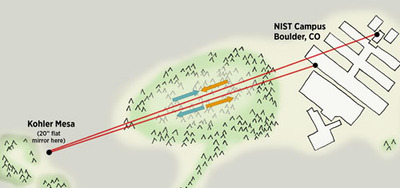Ultraprecise time signals via laser
The optical transfer of timing signals could aid satellite navigation, radar arrays and other applications.
By bouncing eye-safe laser pulses off a mirror on a hillside, researchers at the US National Institute of Standards and Technology (NIST) have transferred ultraprecise time signals through open air with unprecedented precision equivalent to the ‘ticking’ of the world’s best next-generation atomic clocks.
Described in Nature Photonics, the demonstration shows how next-generation atomic clocks at different locations could be linked wirelessly to improve geodesy (altitude mapping), distribution of time and frequency information, satellite navigation, radar arrays and other applications. Clock signals of this type have previously been transferred by fibre-optic cable, but a wireless channel offers greater flexibility and the eventual possibility of transfer to and from satellites.
The stability of the transferred infrared signal matched that of NIST’s best experimental atomic clock, which operates at optical frequencies. Infrared light is very close to the frequencies used by these clocks and both are much higher than the microwave frequencies in conventional atomic clocks currently used as national time standards.
Operating frequency is one of the most important factors in the precision of optical atomic clocks, which have the potential to provide a 100-fold improvement in the accuracy of future time standards. But the signals need to be distributed with minimal loss of precision and accuracy.

The signal transfer demonstration was performed outdoors over a two-way wireless link using two laser frequency combs. A frequency comb generates a steady stream of ultrashort optical pulses with a spacing that can be synchronised perfectly with the ‘ticks’ of an optical atomic clock. In the experiment, the two combs were synchronised to the same stable optical cavity, which serves as a stand-in for an optical atomic clock. Each comb pulse was sent from one of two locations on NIST’s campus in Boulder, Colorado, reflected off a mirror on a mesa behind the campus, and returned to the other site, travelling a total distance of 2 km.
Researchers measured travel times for pulses travelling in opposite directions between the two sites. The cumulative timing differences and frequency instabilities were infinitesimal, just one million-billionths of a second per hour - a performance level sufficient for transferring optical clock signals.
The transfer technique overcomes typical wireless signal problems such as turbulence in the atmosphere - the phenomenon that makes images shimmer when it’s very hot outside. Because turbulence affects both directions equally, it can be cancelled out. The transfer technique can also withstand signal losses due to temporary obstruction of the light path. The method should be able to operate at much longer distances, possibly even over future ground-to-satellite optical communication links as an added timing channel, researchers say.
The combs could potentially be made portable and the low-power infrared light is safe for the eyes. The research is funded in part by the Defense Advanced Research Projects Agency.
Customised rugged tech shaping the next era of defence comms
Rugged computing platforms are becoming central to how armed forces protect communication...
A guide to aquatic survival this summer
While most Australians are planning aquatic adventures this summer, less than a third are...
Maher Terminals enhancing operations with private wireless
Maher Terminals chose the Nokia Edge platform because it needed a secure, reliable,...




